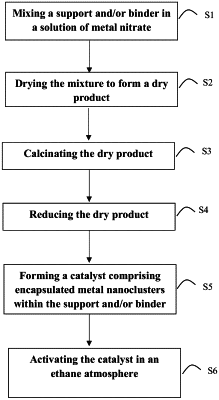| CPC B01J 27/22 (2013.01) [B01J 6/001 (2013.01); B01J 29/40 (2013.01); B01J 35/397 (2024.01); B01J 35/398 (2024.01); B01J 35/40 (2024.01); B01J 35/60 (2024.01); B01J 37/0009 (2013.01); B01J 37/04 (2013.01); B01J 37/16 (2013.01); C07C 5/09 (2013.01); C07C 11/04 (2013.01)] | 4 Claims |

|
1. A catalytic process using a metal carbide nanomaterial comprising steps of:
preparing the metal carbide nanomaterial comprising a support and a plurality of metal carbide nanoclusters encapsulated in a plurality of micropores of the support; and
performing a catalytic hydrocarbon conversion process using the metal carbide nanomaterial,
wherein the catalytic hydrocarbon conversion process is catalytic hydrogenation of acetylene to ethylene, and the metal carbide nanomaterial contains 500 ppm of platinum,
wherein the catalytic hydrogenation of acetylene to ethylene is performed at a temperature between 20 to 200° C., a gas hourly space velocity (GHSV) of acetylene between 10 to 1000 hr−1, and a H2/C2H2 volume ratio between 0.5 to 20,
wherein the metal carbide nanomaterial is prepared by a method comprising the following steps:
Step 1: mixing ZSM-5 powder having a silica to alumina molar ratio of 30 in a solution of Pt(NO3)2 to form a mixture;
Step 2: drying the mixture to form a dry product;
Step 3: calcinating the dry product at 550° C. for 4 hours;
Step 4: reducing the dry product in hydrogen at 630° C. for 1 hour;
Step 5: forming a catalyst comprising encapsulated metal nanoclusters within the support; and
Step 6: activating the catalyst at 300˜500° C. in an ethane atmosphere balanced with 50% by volume of nitrogen.
|